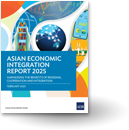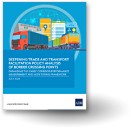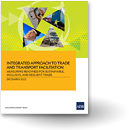How to Advance Green, Inclusive Trade through E-commerce in Asia and the Pacific
Greater transparency is required to make global trade and supply chains more reliable and to ensure sustainability and social standards are met. But that is easier said than done.
E-commerce has emerged as a vital force in the global economy, with Asia and the Pacific leading the charge, accounting for more than half of global retail sales.
This trend is expected to continue, with the share of global GDP attributed to e-commerce rising from 3.8% in 2019 to 5.4% in 2021. Projections show an increase further to 6.4% by 2025.
Technology has been a key driver of ecommerce growth. Increased internet access, widespread smartphone adoption, and emerging technologies like augmented and virtual realities are shifting consumer preferences and linking a wide range of products and sellers with customers efficiently.
In addition, more open trade regimes and advancements in trade facilitation measures across the region have lowered the costs of cross-border trade.
Large firms are increasingly leveraging artificial intelligence (AI) to reduce costs and automate process. Such innovative technologies will enhance global ecommerce, particularly in areas like product discovery, customer experience, and regulatory compliance.
However, e-commerce readiness across countries and communities remains uneven, and various aspects must be addressed to ensure that its growth is both inclusive and sustainable.
Key action areas include strengthening support for vulnerable groups, safeguarding the environment, and promoting fair competition and effective taxation policies.
Leveraging e-commerce for inclusive development comes with significant challenges, particularly for small businesses. The digital divide also remains a significant issue across economies and for vulnerable groups of people, due to difference in digital infrastructure.
The logistical challenges require ongoing improvements in infrastructure to support small business growth. Barriers such as a lack of physical collateral complicate financing, especially for cross-border e-commerce.
To address this, a holistic policy approach is needed to help small and medium-sized businesses (SMEs) navigate the export process, from ensuring product quality and managing logistics to simplifying import procedures, payment systems, and connecting with end consumers.
A piecemeal approach may fail to remove persistent barriers and limit the engagement of SMEs in cross-border e-commerce.
While e-commerce has created business opportunities for SMEs and women in many countries, achieving the full "last mile" benefits of e-commerce, especially for the poor and least developed countries, remains a challenge.
To better harness the potential of cross-border e-commerce, countries in Asia and the Pacific, especially the least developed, should accede to the Framework Agreement on Facilitation of Cross-Border Paperless Trade in Asia and the Pacific, enabling them to participate in collective efforts to foster inclusive growth.
The climate crisis presents another significant challenge for e-commerce. Although e-commerce reduces the need for travel and paper use, the rise in delivery trucks, packaging waste, and frequent returns contributes to greenhouse gas emissions.
E-commerce has created vast opportunities for businesses, but ensuring its growth is inclusive, sustainable, and equitable requires coordinated efforts across policy, infrastructure, and regulation.
Large companies have already taken steps to reduce their environmental impact. For example, DHL is investing significantly in sustainable aviation fuel and aims to use 30% sustainable fuel by 2030.
However, smaller ecommerce businesses often prioritize immediate financial goals over sustainability due to slim profit margins and price-sensitive markets in Asia and the Pacific. Sustainable practices often incur additional costs and are overshadowed by more pressing policy issues related to SMEs and short-term business survival.
Effective collaboration between public and private sectors, along with clear benchmarks and incentives, is essential for advancing sustainable e-commerce practices and achieving long-term sustainability targets.
Efforts such as route optimization, consolidating shipments, and adoption of electric vehicles can reduce emissions. Additionally, shared warehouse management systems can also reduce environmental footprints by supporting multiple firms with common origin depots and delivery schedules.
Shifts in consumer expectations towards sustainability require changes in consumption patterns. Realistic expectations need to be set, as consumers often demand low prices, fast delivery, and high quality, which can conflict with sustainability goals.
E-commerce has significantly expanded consumer choice and opened new markets for sellers. However, as the industry grows, there are discussions about how to maintain a level playing field, especially as some platforms gain substantial market share.
They raised concerns about platform dominance, consumer lock-in, and data monopolies, which may limit new entrants and stifle innovation.
It is important to consider how economies of scale and access to information can impact competition and innovation within the industry. Additionally, the collection and use of personal data is an area that continues to evolve, which requires stronger efforts to ensure transparency and security.
AI-powered tools, such as biometric verification and fraud detection systems, can be used to combat the rising threat of fraud and scams in e-commerce.
Balancing data protection with secure sharing practices is essential for fostering innovation and competition. Various regulatory approaches should be considered to manage the dynamic nature of digital markets.
Key recommendations for a conducive digital economy regulatory approach include establishing a supportive environment through national plans, strategies, and cross-agency coordination. It is essential to clarify roles, responsibilities, and data governance while leveraging existing and new tools rather than creating additional laws.
Taxation is another important regulatory area, especially in light of the rapid growth of e-commerce. The rise of online transactions has added layers of complexity to monitoring and taxing digital goods, particularly when it comes to cross-border transactions.
The ability of companies to provide services in markets where they do not have a physical presence challenges traditional tax systems, complicating various types of taxes, such as consumption taxes, income taxes, and customs duties.
To address these issues, multilateral organizations, such as the OECD and the UN, are developing international tax frameworks that prioritize tax neutrality, efficiency, simplicity, fairness, and flexibility.
These frameworks aim to clarify how taxes are applied in the digital realm, ensuring that regulations are clear and consistent across borders. As cross-border e-commerce continues to grow, international cooperation remains essential for effective taxation in this evolving landscape.
Yoonee Jeong, Senior Digital Technology Specialist with the Asian Development Bank, contributed to this blog post.
Original article was published at the Asian Development Blog and duplicated here with permission from the authors. *




